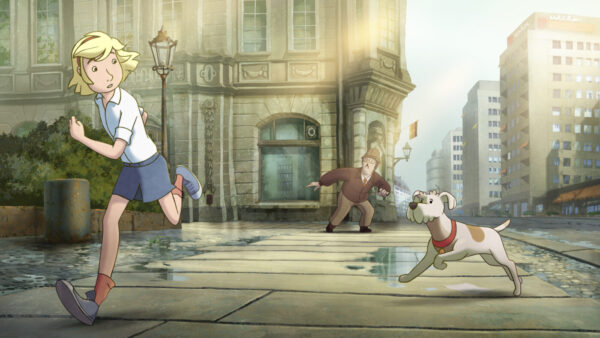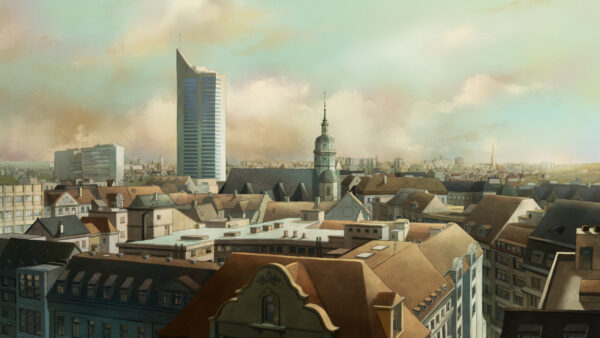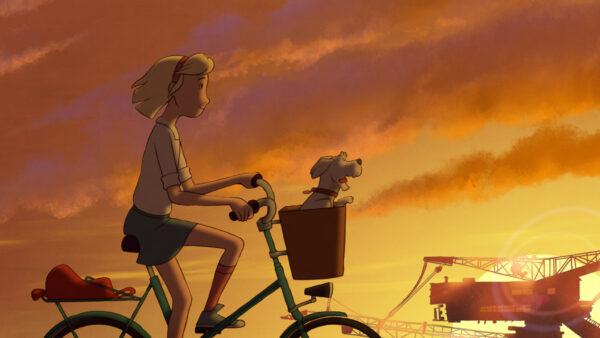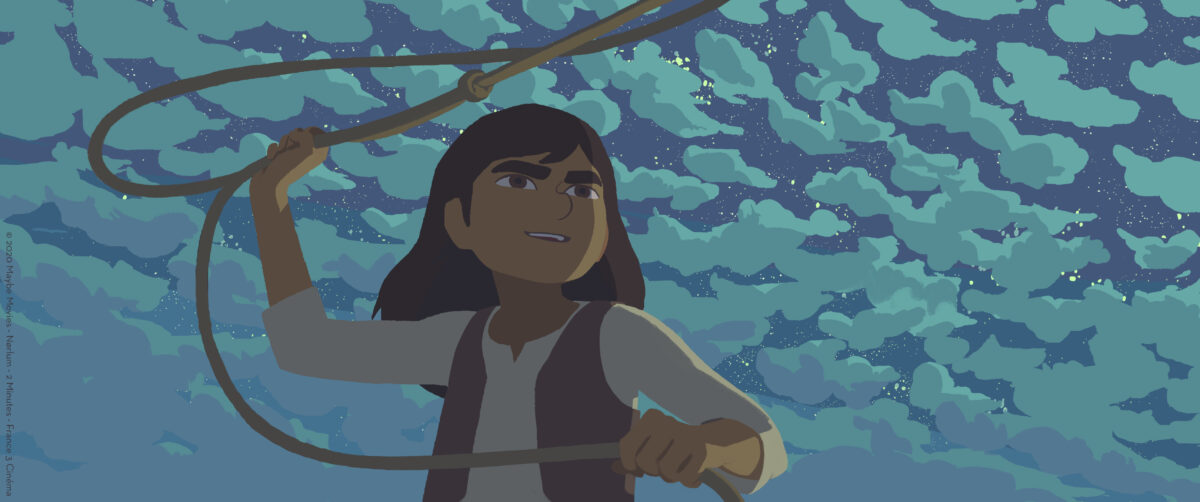“You can still recognize what is a Trabant, a Wartburg, or a Skoda”. Ralf Kukula & Matthias Bruhn about ‘Fritzi: A Revolutionary Tale’

A beautiful summer in East Germany, 1989. Nothing suggests the big socio-political changes that are just around the corner. Twelve-year-old Fritzi is occupied by more important matters: she has to take care of her best friend Sophie’s dog Sputnik, while Sophie’s family is on vacation. When after the holidays Sophie still hasn’t come back, Fritzi and Sputnik set out in search of her. A postcard from West-Germany puts her on the right track. This quest unexpectedly leads Fritzi into the eye of an international political hurricane.
By chance, Fritzi stumbles into a demonstration. She sees the people around her risking arrest, committed to changing their country for the better. Even her father is getting involved. Will Fritzi be so brave to rescue the dog, the friend and the father all at once? This historically accurate and authentic animated feature describes a peaceful revolution as seen through the eyes of a young girl. An exciting tale of the Fall of the Wall, and of the people who were brave enough to make things happen.
What a great idea to use a dog as the motor behind the story.
Matthias Bruhn: Sputnik was an idea of our scriptwriter, Beate Völcker. Our movie is based on the children's book Fritzi was there by Hanna Schott, a short novel in which Fritzi is more an observer of the events around her. For Beate it was clear that Fritzi needed to be a stronger, more active character. She changed her age from 8 to 12 years, and added the story of Fritzi’s best friend Sophie and her dog. Sputnik is the emotional motivation for all of Fritzi’s actions. Like a real dog, Sputnik is super cute, and young viewers can immediately connect to both him and Fritzi.

Were you never afraid this story would only concern German children or their parents? To be honest: I was, until your film proved me wrong.
Ralf Kukula: In essence, our story is one about universal values. Children of all nations can understand what it means to lose your best friend, and to fight for the truth, even if the going gets tough. We were optimistic right from the start that our film could work internationally, due to the feedback from our foreign co-production partners. At the world premiere in Belgium, there was a standing ovation when the border opened up. These were children who probably never heard about the fact that there once was the GDR and Germany used to be a divided nation.

Still there was a socio-political background that you needed to explain and that children needed to understand to fully capture the story.
Bruhn: We are telling the story completely from Fritzi’s point of view. In the beginning Fritzi is quite naïve, she doesn’t know about politics. She simply wants to deliver Sputnik back to her best friend, who has fled with her mother to West Germany. But the more Fritzi gets an understanding of the situation in her country, the more she develops her own opinion. Young viewers can totally identify with Fritzi, they are always at eye level with her. Even if kids don’t get all the historical details – unlike most of the parents or grandparents in the audience – we made sure they can follow Fritzi on her emotional journey.

Did you remember exactly how the city looked, back in those days? The parks, the streets, the smokestacks on the horizon, was it all still vivid in your memory?
Kukula: We have paid great attention to the design of our backgrounds into the smallest details. We treated them like an independent protagonist, enabling us to tell about the spirit of those days. On one hand, we trusted the memories of our East German crew members. On the other hand, throughout our research we received enthusiastic support from the archives. We noticed again and again how parents and grandparents reacted to the high precision in our backgrounds that sent them on a time-travel back into their memories. Many were moved to tears and would never have believed that an animated film could have such an effect.
There is this one specific detail in the city landscape: the cars! They even sound like the old models.
Kukula: Cars are always a statement of their time. All vehicles in the film are replicas of the originals. Alienated, but in such a way that you can still recognize what is a Trabant, a Wartburg, a Skoda or an Ikarus bus. The sounds were all recorded from the original vehicles. There is a funny little clip from those recordings on the Fritzi Facebook Site.

What about that creepy teacher? Was she a typical example of East German school teachers back then?
Kukula: I had a German teacher who was just like her, a party member who was determined to deny young people their future if they did not behave in a consistent manner. For our young audience it was important to characterise her as a true antagonist, but it is clear that not all teachers in the GDR were like her.
You incorporated a few images from the TV-news in the animation. A lovely idea!
Bruhn: We decided to use original footage from TV-News archives. Some of the scenes, e.g. Hans Dietrich Genscher on the balcony of the Embassy in Prague, are part of our “collective memory”. For the German version, we also used the original voices of Genscher or later, Schabowski. We added some digital filters to make the material fit into the 2D-design of the movie.
As the story evolves, the atmosphere of an uprising grows and intensifies, together with the atmosphere of fear. How did you juxtapose them in the film?
Bruhn: Even if ‘Fritzi’ is a children’s movie we didn’t want to trivialize the atmosphere of fear. Fritzi’s father getting arrested during a demonstration is a tough moment in the movie. When Fritzi convinces her mother not to be intimidated but to join the demonstration together with her instead, this moment has a positive emotional impact that you can only reach if you allow some extremes. We tried to keep a balance between intense and sometimes sad moments and ones of joy and fun. After all, ‘Fritzi’ is not a comedy but a drama. Which is quite unusual for a children’s film.

During the uprising, we see a colourful groups of people demonstrating together: there are hippies and punks, young progressives and retired people… all coming together with one goal.
Kukula: The first demonstrations were strongly influenced by people who came from the periphery of the churches in the GDR, or activists from the environmental organisations. The demonstrators were indeed a diverse mix. Especially after the big demonstrations in October 1989 the atmosphere became more relaxed, the banners became more brave and more funny. Never again in my life have I experienced such a situation in which total strangers courageously and honestly set out for a common goal. Only the days immediately after the Fall of the Wall in November and December 1989 could top this.
The animation reminds me of the comic books of my youth: clear colours, strong lines…
Bruhn: You’re right, the “ligne claire” from comic books from the 70s and 80s has been an inspiration for our design. We stand closer to Japanese anime than to Disney movies. Our great team of artists developed a unique style, a kind of nostalgic reference to the good old 2D movies from the eighties. But if you take a closer look you will notice that we made a 2D movie by the use of the latest digital technology. The cars are 3D objects, some of the crowd-scenes are computer generated and in the compositing we added hundreds of digital FX to perfectly recreate the look of the late 80s. But even when using digital pencils and colours, the animation of the characters and backgrounds is 100% hand drawn. Contrary to many perfect CGI movies, the “imperfection” of the 2D style adds an emotional warmth to our movie.


